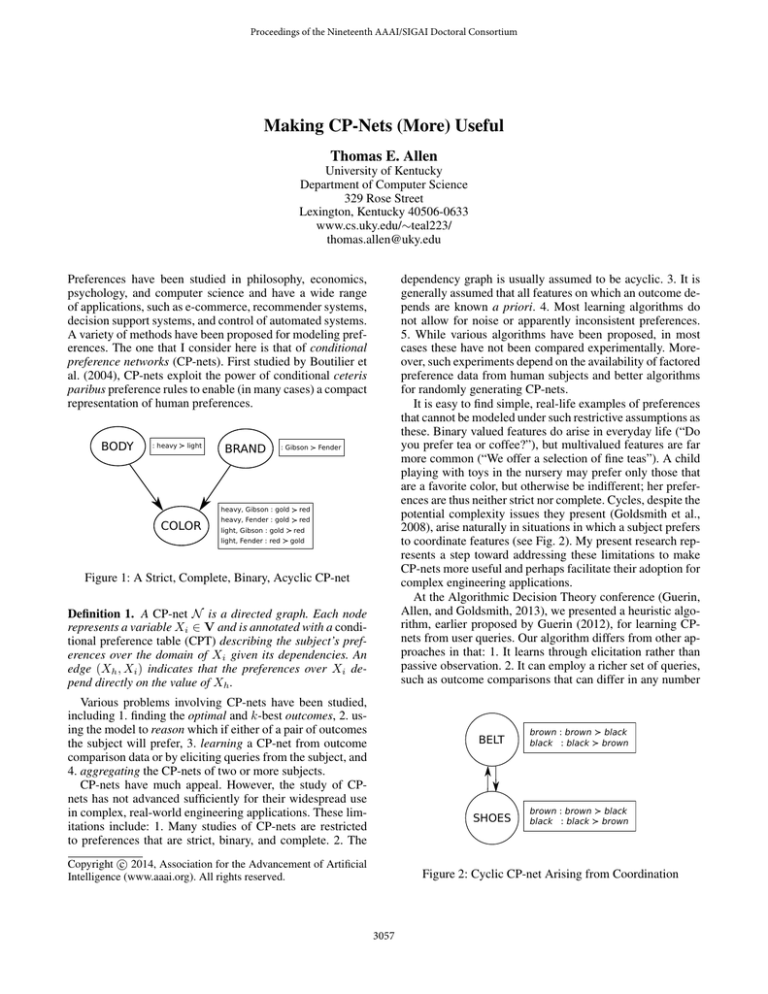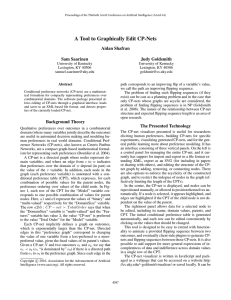
Proceedings of the Nineteenth AAAI/SIGAI Doctoral Consortium
Making CP-Nets (More) Useful
Thomas E. Allen
University of Kentucky
Department of Computer Science
329 Rose Street
Lexington, Kentucky 40506-0633
www.cs.uky.edu/∼teal223/
thomas.allen@uky.edu
Preferences have been studied in philosophy, economics,
psychology, and computer science and have a wide range
of applications, such as e-commerce, recommender systems,
decision support systems, and control of automated systems.
A variety of methods have been proposed for modeling preferences. The one that I consider here is that of conditional
preference networks (CP-nets). First studied by Boutilier et
al. (2004), CP-nets exploit the power of conditional ceteris
paribus preference rules to enable (in many cases) a compact
representation of human preferences.
BODY
: heavy
light
COLOR
BRAND
: Gibson
heavy, Gibson : gold
red
heavy, Fender : gold
red
light, Gibson : gold
red
light, Fender : red
gold
dependency graph is usually assumed to be acyclic. 3. It is
generally assumed that all features on which an outcome depends are known a priori. 4. Most learning algorithms do
not allow for noise or apparently inconsistent preferences.
5. While various algorithms have been proposed, in most
cases these have not been compared experimentally. Moreover, such experiments depend on the availability of factored
preference data from human subjects and better algorithms
for randomly generating CP-nets.
It is easy to find simple, real-life examples of preferences
that cannot be modeled under such restrictive assumptions as
these. Binary valued features do arise in everyday life (“Do
you prefer tea or coffee?”), but multivalued features are far
more common (“We offer a selection of fine teas”). A child
playing with toys in the nursery may prefer only those that
are a favorite color, but otherwise be indifferent; her preferences are thus neither strict nor complete. Cycles, despite the
potential complexity issues they present (Goldsmith et al.,
2008), arise naturally in situations in which a subject prefers
to coordinate features (see Fig. 2). My present research represents a step toward addressing these limitations to make
CP-nets more useful and perhaps facilitate their adoption for
complex engineering applications.
At the Algorithmic Decision Theory conference (Guerin,
Allen, and Goldsmith, 2013), we presented a heuristic algorithm, earlier proposed by Guerin (2012), for learning CPnets from user queries. Our algorithm differs from other approaches in that: 1. It learns through elicitation rather than
passive observation. 2. It can employ a richer set of queries,
such as outcome comparisons that can differ in any number
Fender
Figure 1: A Strict, Complete, Binary, Acyclic CP-net
Definition 1. A CP-net N is a directed graph. Each node
represents a variable Xi ∈ V and is annotated with a conditional preference table (CPT) describing the subject’s preferences over the domain of Xi given its dependencies. An
edge (Xh , Xi ) indicates that the preferences over Xi depend directly on the value of Xh .
Various problems involving CP-nets have been studied,
including 1. finding the optimal and k-best outcomes, 2. using the model to reason which if either of a pair of outcomes
the subject will prefer, 3. learning a CP-net from outcome
comparison data or by eliciting queries from the subject, and
4. aggregating the CP-nets of two or more subjects.
CP-nets have much appeal. However, the study of CPnets has not advanced sufficiently for their widespread use
in complex, real-world engineering applications. These limitations include: 1. Many studies of CP-nets are restricted
to preferences that are strict, binary, and complete. 2. The
c 2014, Association for the Advancement of Artificial
Copyright Intelligence (www.aaai.org). All rights reserved.
BELT
brown : brown
black : black
black
brown
SHOES
brown : brown
black : black
black
brown
Figure 2: Cyclic CP-net Arising from Coordination
3057
algorithm attempts to approximate the subject’s preferences
as closely as possible rather than recovering the original CPnet exactly, I conjecture that it will prove resilient in the
presence of noise or occasional inconsistent responses. I am
planning new experiments to test this assumption.
My next project involves extending my earlier
work (Allen, 2013) on the expected length of flipping
sequences and the diameter of a CP-net. For that I plan to
perform a further series of experiments involving 1. randomly generated networks with features that vary in the
number of values (rather than domains of uniform size),
2. networks with particular structures in which long flipping
sequences may be more common (e.g., chain-shaped
CP-nets), and 3. CP-nets learned from data as well as those
that are generated randomly. From these experiments I hope
to obtain a formal statistical model of the expected length of
a flipping sequence and diameter of a CP-net parameterized
by its number of variables, the size of their respective
domains, the number of rules in the CPTs, and constraints
on the structure of the network. I hope to have much of this
work completed prior to the AAAI conference.
Following the conference, I plan to study the problem
of learning CP-nets in which the subject prefers to coordinate the values of two or more features, as in the example in Fig. 2. To my knowledge, all present CP-net learning algorithms fail to represent correctly the subject’s preferences when features are coordinated in this way. Present
algorithms either misinterpret the preferences or fail to output a CP-net at all. I hope instead to detect such preferences
directly and resolve the cyclic relationship among the features by 1. merging the coordinated variables, 2. inferring
the presence of a latent variable on which the nodes that are
involved in the cycle mutually depend, or 3. learning and
outputting a consistent CP-net that contains an actual cycle
in the dependency graph. I also plan to study the complexity
of cyclic CP-nets in which the length of the longest cycle is
bounded by a small constant.
of variables and attribute comparisons that offer a heuristic for faster learning. 3. The algorithm is robust: it will always output a CP-net, never failure. 4. While the algorithm
does not always recover the original CP-net, the learned CPnet that it outputs is guaranteed to be consistent with the
original on all queries encountered in the learning process.
5. The algorithm is efficient, assuming a bound on in-degree;
that is, if a preference order can be represented as a CP-net,
the algorithm learns a CP-net in time O(np ), where n is the
number of nodes (features) and p is a bound on the number of parents a node may have. 6. We employed an experimental approach to evaluate our algorithm, simulating the
query process using randomly generated CP-nets. For the
conference paper, I planned and performed additional experiments, including a series that used statistical sampling
when exhaustive analysis was infeasible. I also modified the
algorithm that randomly generated CP-nets to exclude the
possibility of degenerate CPTs that could conflict with the
dependency graph. The resulting set of experiments demonstrated that the learned CP-nets agree with the originals on a
high percent of non-training preference comparisons.
Most research on CP-nets assumes strict, complete preferences over binary variables. In an invited paper at the Allerton Conference (Allen, 2013), I relaxed these assumptions
to explore the problems of learning and reasoning with CPnets that can model preferences over multi-valued variables
over which the subject may be indifferent. I presented the
case that such CP-nets are necessary for many simple, realworld problems. I then showed how to leverage the power
of SAT solvers to learn and reason with such CP-nets. The
problem of reasoning with CP-nets is generally framed as
one of searching for a transitive sequence from one outcome to the other that is consistent with the rules in the
CPTs. The planning algorithm that I proposed outputs such
a flipping sequence, provided at least one exists and that its
length can be bounded by a constant. However, Boutilier et
al. (2004) proved that for multivalued, incomplete CP-nets,
the sequence may be exponentially long in the number of
variables in the worst case. Thus, the problem of reasoning
with CP-nets is not in NP: even if we could somehow guess
a correct flipping sequence, the problem of verifying the sequence could be intractable. Nevertheless, there is reason to
believe that this worst-case scenario is rare. In a series of experiments, I showed that most flipping sequences are likely
to be short and that a longest flipping sequence (the diameter of the CP-net) is also likely to be short, at least in the
case of randomly generated CP-nets, I further showed that,
even if very long flipping sequences do occasionally exist
in learned or elicited CP-nets, they are unlikely to provide
useful information about the actual preferences of a human
subject if there is some small probability that the rules in
the CPTs are noisy.
In our ADT paper (Guerin, Allen, and Goldsmith, 2013)
we limited our study to learning strict, binary CP-nets. For
the journal paper, I am extending the algorithm to allow
for generally multivalued variables. Moreover, the subject
would be permitted to answer with indifference or to decline
to answer altogether, as well as well as expressing a strict
preference over outcomes or features. Additionally, since the
References
Allen, T. E. 2013. CP-nets with indifference. In Communication, Control, and Computing (Allerton), 2013 51st
Annual Allerton Conference on, 1488–1495. IEEE.
Boutilier, C.; Brafman, R. I.; Domshlak, C.; Hoos, H. H.;
and Poole, D. 2004. CP-nets: a tool for representing and
reasoning with conditional ceteris paribus preference statements. Journal of Artificial Intelligence Research 21:135–
191.
Goldsmith, J.; Lang, J.; Truszczyński, M.; and Wilson, N.
2008. The computational complexity of dominance and consistency in CP-nets. Journal of Artificial Intelligence Research 33:403–432.
Guerin, J. T.; Allen, T. E.; and Goldsmith, J. 2013. Learning
CP-net preferences online from user queries. In Proc. ADT,
LNAI. Springer.
Guerin, J. T. 2012. Graphical Models for Decision Support in Academic Advising. Ph.D. Dissertation, University
of Kentucky.
3058






